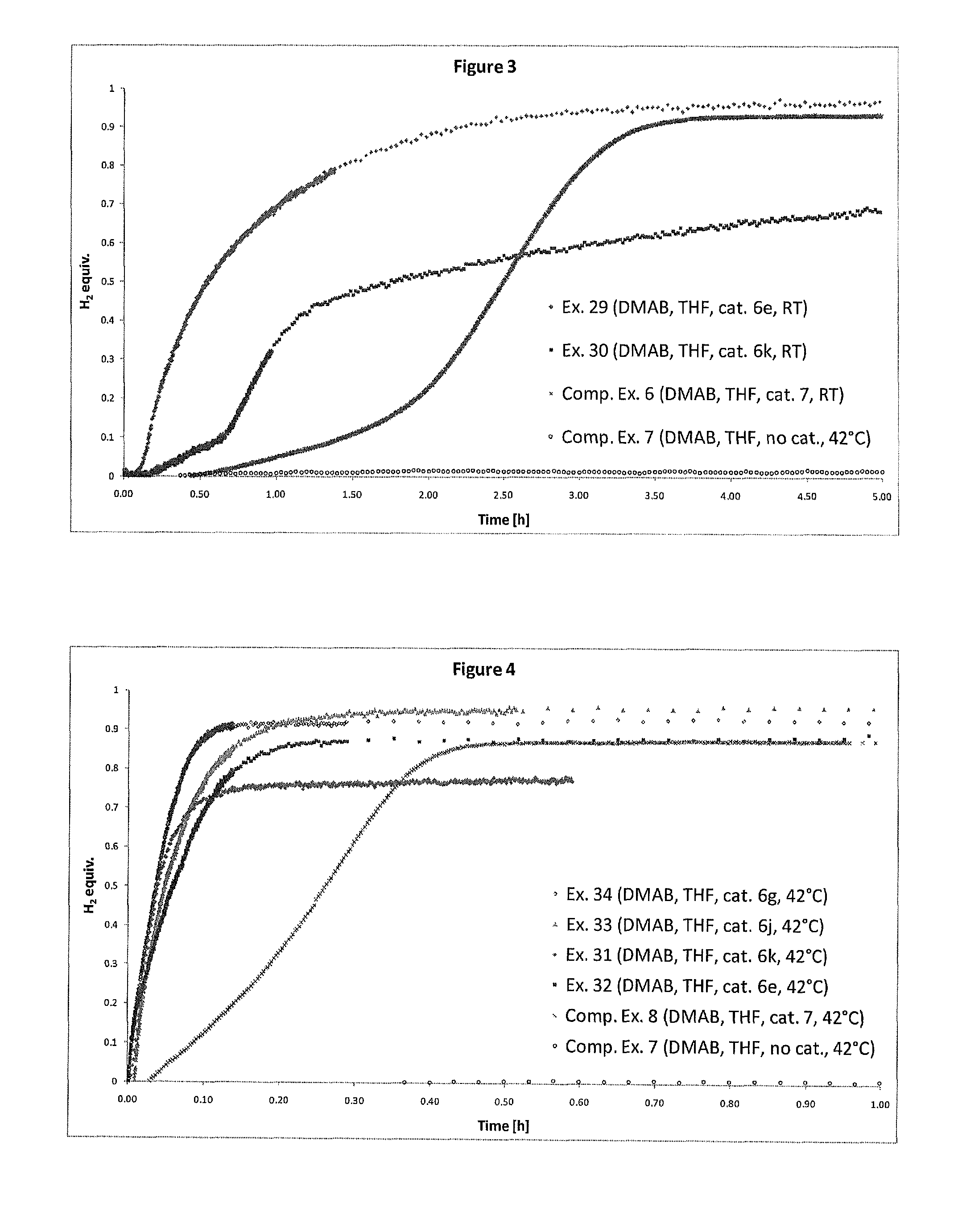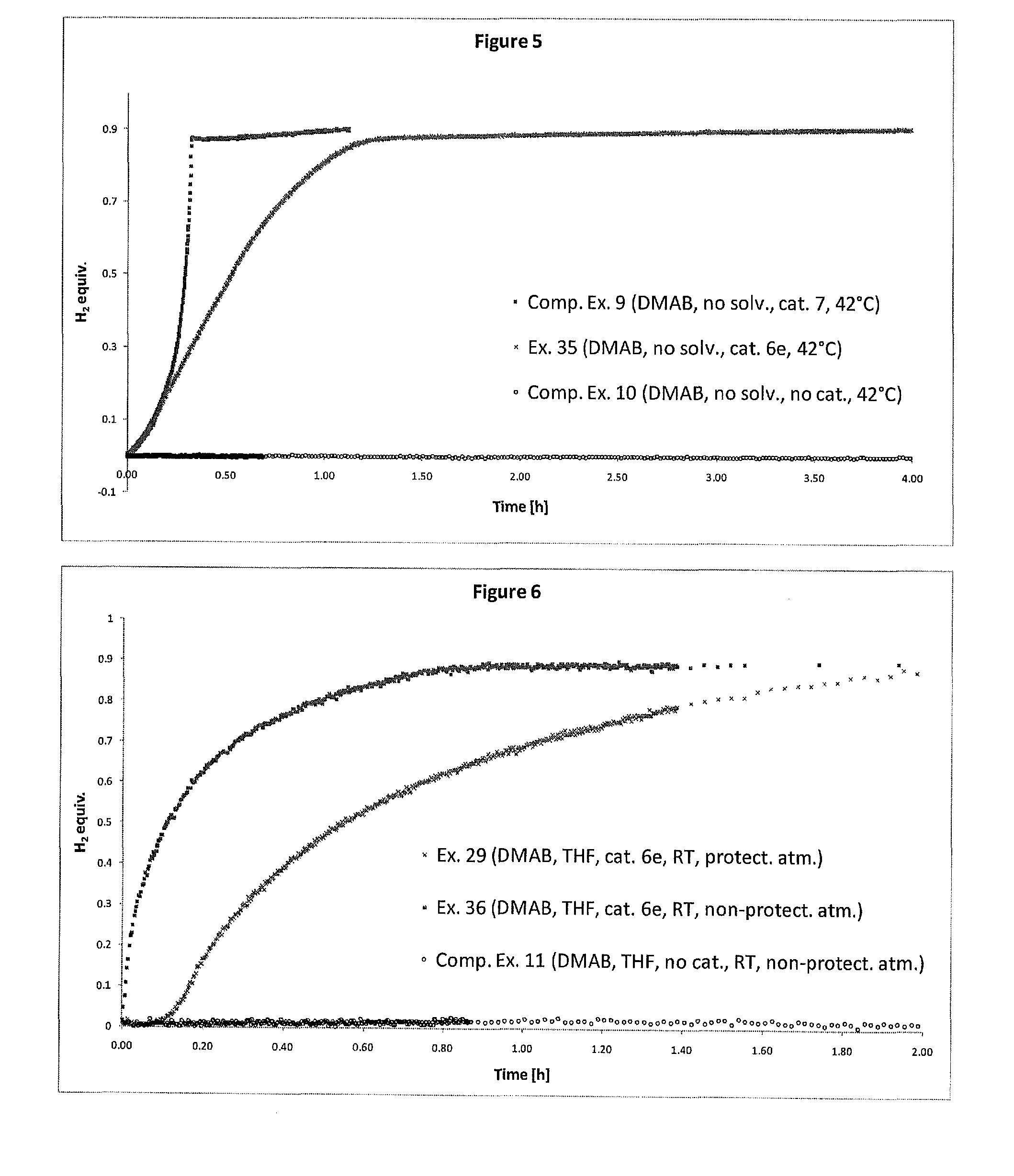Catalyst and Process for the Production of Hydrogen from Ammonia Boranes
a technology of ammonia boranes and catalysts, which is applied in the direction of physical/chemical process catalysts, gas-gas reaction processes, osmonium organic compounds, etc., can solve the problems of difficult regeneration of spent fuel, significant hazard in refilling pressurized hydrogen, and significant waste of energy in carrying extra weight, etc., to achieve enhanced dehydrogenation kinetics and high yield
- Summary
- Abstract
- Description
- Claims
- Application Information
AI Technical Summary
Benefits of technology
Problems solved by technology
Method used
Image
Examples
example 1
Synthesis of Ligand 2a (Scheme 1)
N,N′-Bis(2-methylthiophenyl)-2,4-dimethyl-1,3-diketimine (2a) CAS 1198159-02-2
[0149]Compound 2a has been described by Pfirrmann et al (Z. Anorg. Allg. Chem. 2009, 635, 312-316). We describe a slightly modified procedure with improved yield. Acetylacetone (1.14 mL, 11.1 mmol) and p-toluenesulfonic acid monohydrate (4.23 g, 22.2 mmol) were added to a 3-neck round-bottom flask with a Dean-Stark apparatus connected. Degassed toluene (150 mL) and 2-methylthioaniline 1a (3.35 mL, 26.75 mmol) were added to give a green solution, and the mixture refluxed at 150° C. for 24 hours. The resulting yellow solution was cooled, and solvent removed. The resulting oil was taken up in dichloromethane (100 ml) and stirred with a solution of sodium carbonate (40 g in 100 ml H2O) for 30 minutes. The organic layer was separated and the aqueous layer extracted with dichloromethane (3×50 mL), the organic layers were combined, washed with brine, and dried over magnesium sulfa...
example 2
Synthesis of Ligand 2b (Scheme 1)
N,N′-Bis(2-ethylthiophenyl)-2,4-dimethyl-1,3-diketimine (2b)
[0151]The synthesis follows the synthesis for 2a by Pfirrmann et al (Z. Anorg. Allg. Chem. 2009, 635, 312-316). Acetylacetone (1.98 g, 19.7 mmol) and p-toluenesulfonic acid monohydrate (3.76 g, 19.7 mmol) were added to a 3-neck round bottom flask with a Dean-Stark apparatus connected. Degassed toluene (150 mL) and 2-ethylthioaniline 1b (6.06 g, 39.55 mmol) were added to give a brown solution, and the mixture refluxed at 150° C. for 24 hours. The resulting purple solution was cooled, and solvent removed. Saturated sodium carbonate (40 g in 200 mL water) and dichloromethane (200 mL) was added to this and stirred for 30 minutes, to give an orange solution which was extracted with dichloromethane (3×50 mL), the organic layers were combined, washed with brine, and dried over magnesium sulfate. The solvent was removed to give a yellow oil. A filtration on silica gel was carried out to remove monos...
example 3
Synthesis of Ligand 2c (Scheme 1)
N,N′-Bis(2-methoxyphenyl)-2,4-dimethyl-1,3-diketimine (2c) CAS 613685-98-6
[0153]Compound 2c has been synthesized according to the procedure described by Carey et al (Dalton Trans. 2003, 1083-1093). The analytical data correspond to the literature.
PUM
| Property | Measurement | Unit |
|---|---|---|
| flow rate | aaaaa | aaaaa |
| pressure | aaaaa | aaaaa |
| weight | aaaaa | aaaaa |
Abstract
Description
Claims
Application Information
 Login to View More
Login to View More - R&D
- Intellectual Property
- Life Sciences
- Materials
- Tech Scout
- Unparalleled Data Quality
- Higher Quality Content
- 60% Fewer Hallucinations
Browse by: Latest US Patents, China's latest patents, Technical Efficacy Thesaurus, Application Domain, Technology Topic, Popular Technical Reports.
© 2025 PatSnap. All rights reserved.Legal|Privacy policy|Modern Slavery Act Transparency Statement|Sitemap|About US| Contact US: help@patsnap.com



